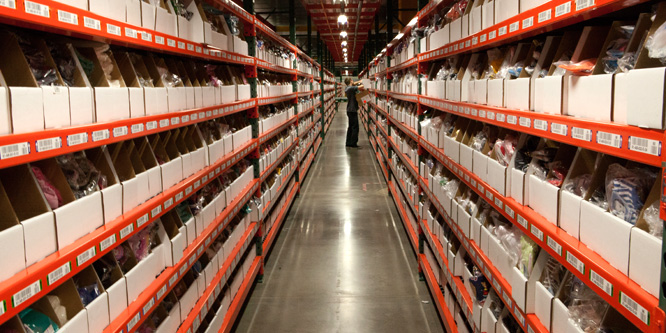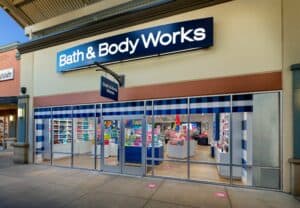
Photo: Walmart
July 26, 2018
Study: Online retailers losing billions in sales to out-of-stocks
Out-of-stocks are a problem for retailers that may be almost twice as bad online than in stores. That’s the conclusion of new research from the Grocery Manufacturers Association (GMA), which found sites across the globe could be losing billions in sales every year because products aren’t available online when consumers wish to purchase them.
The report, “A Worldwide Study of Extent, Shopper Reactions, and Implications for Non-Food Online Retail Categories,” written by Daniel Corsten, professor of operations and technology and IE Business School, and Thomas Gruen, professor of marketing at the University of New Hampshire, tracked online product availability of baby care, fabric care, hair car, oral care, skin care and shaving products on websites operated by retailers in China, France, Germany, Japan, the UK and the U.S.
“This is one of the first studies on online availability after previous reports over the past decade studying on-shelf availability and its effects on consumer purchasing patterns,” said Keith Olscamp, director of industry affairs and collaboration at GMA, in a statement. “The findings should encourage retailers and brands to collaborate and enhance online availability in the fast-growing area of online retail.”
The GMA research found that out-of-stocks on the categories covered in the report was 15 percent online compared to 8.3 percent in physical stores.
The somewhat good news for e-tailers in these findings is that, unlike consumers in stores who will walk if a product is out-of-stock, those same shopping online are more likely to look for a substitute product rather than going to another site or a physical location.
Despite the silver lining, the report finds that both online retailers and brands are hurt by out-of-stocks, with U.S retailers taking “25 percent of the adverse consequences compared to 35 percent for brands.”
Discussion Questions
DISCUSSION QUESTIONS: Do you see out-of-stocks as a significant problem for retailers selling online? Are the solutions for avoiding out-of-stocks different online than in stores? If yes, how?
Poll
BrainTrust
John Karolefski
Editor-in-Chief, CPGmatters
Recent Discussions








Out-of-stocks are a conversion killer – online or offline. Offering the proverbial endless-aisle of product online is relatively easy, but managing the inventory and distribution logistics effectively is hard. All retailers need to manage out-of-stocks and there are plenty of solutions to help them do that. However, beyond “solutions,” retailers need experienced personnel to execute.
This is indeed a legitimate problem for online retailers — despite the theoretical silver lining referenced in this article.
I’ll be discussing this and other inventory issues at the upcoming ECRM Healthcare conference. Managing availability across the supply chain (whether online or brick-and-mortar) has been an age-old problem for retail. With expansive inventories offered online this problem is further accentuated and, yes, it is a significant issue affecting shopper satisfaction, retail experience and loyalty.
Consumers easily pivot to an alternative in out-of-stock situations. The wounds of disappointment heal quickly as they discover other options. The big harm is to brand loyalty in this “if you can’t do it, I’ll go to somebody who can” world. Too many out-of-stock experiences erode any confidence that the consumer wants to have in the online or retail location. It bears noting that Amazon is very aggressive in monitoring consumer perception of third-party fulfillment.
This points to some of the basics of retailing about which few people and publications are talking these days: merchandise planning, automated replenishment and inventory management. If retailers don’t do these things correctly, it matters little with what customers they engage on a highly-personalized basis. I would think that it is easier to stay in stock in distribution centers — where quantities of any one SKU are larger than in individual stores – than it is to stay in stock in stores. However, if a retailer is out of stock across the enterprise, but a purchase order has been placed with the supplier, it is possible to let the online customer know that the item will be available on a specific date (depending on the reliability of the supplier) and try to avoid the cart abandonment/save the sale.
I completely agree with Mark. Out-of-stock is a conversion killer in-store. For orders that get shipped to the shopper, out-of-stock raises the RSO (Retail Ship:Order) ratio that kills margin. RSOs over 1.0 means you are shipping multiple boxes for each order placed. That means the retailer is picking up that expensive last-mile shipping cost.
Nothing can replace a solid demand planning forecast. But forecasts will always be wrong (even the best of us cannot predict the future). Retailers committed to omnichannel can mitigate some of the impact of out-of-stock with endless aisle, solid order routing and other techniques. To keep your RSO down, look to make sure your retail technology has order consolidation turned on.
I suspect that the numbers are actually worse than this study suggests because many grocers will show a product as being available but will then, when it comes to picking it, will find it is isn’t and will substitute an alternative.
Needless to say, all of this frustrates consumers and erodes loyalty, conversion and spend.
Out-of-stocks are a material issue for retailers. Consumers today are list-driven; having what you say you have, or what a consumer expects you to have in inventory is critical. Brick-and-mortar retailers require a holistic approach to maintaining high inventory accuracy. In-store, merging RFID, video, location and POS data with machine learning can yield incredible results of inventory accuracy, nearing 100 percent perpetually. This allows for smarter replenishment models, which leads to higher customer satisfaction and conversion, thus higher revenue, for in-store shoppers; while also realizing almost guaranteed hit rates for BOPIS and ship-from-store orders. The store needs to be digitized too.
Having gotten to the point of deciding to buy and then finding out what you want is out of stock makes for a frustrating experience. Some brands are using tricks online such as “Email me when a product is back in stock” but how well this works is unclear.
Having a handle on inventory and supply chain could help the online experience by providing a level of context of when something may be back in stock. Though I suspect out-of-stocks mostly appear when the sales are on and stock is being cleared, thus wont be returning. In which case being visibly proactive in suggesting relevant substitutes could help those who do look for substitutes, as George mentioned in the article.
What I would like to know is how the out-of-stock in stores was calculated. Is it out-of-stock percent for each store, averaged across all stores? Or was it the aggregate inventory level across stores and then calculated at that level? Because I suspect that the average store is not out-of-stock on only 8.3 percent of items — I would expect a higher out-of-stock number for individual stores.
And then there is the whole “actual” out of stock vs. “perceived” out of stock — and I would bet that stores suffer way more here than online does. If a consumer can’t find the item in the store, even if it’s there, they believe the retailer is out of stock and that shapes their overall perception of the brand. I once saw an estimate of this phenomenon, and it was as high as 30 percent perceived out of stock, when the actual out of stock in the store was less than half that.
This is why showing store inventory online is so important, even if it is only a guideline like “high availability” or “running low.” An online DC might carry more inventory than a store, but not that much more — probably not more than three to five stores, for your “average” retailer I’m guessing (could definitely be wrong though). So you’re only going to have so much availability if you’re only pulling from the online DC. But when you can tap into store inventory, even if it’s only to direct consumers to go to their local store, you have a much wider pool of inventory to play with.
I think the most important thing to remember with out-of-stocks, though, is that in this day and age, consumers are much less likely to switch brands and stick with the retailer than they are to ditch the retailer in search of the brand. I see it in my own behavior too — outside of very low consideration items like bags of frozen peas, if a store doesn’t have it, I’m opening the Amazon app next. And online, there are a ton of competitors who might have specifically what I want that are only a tab away.
First of all I find it interesting that the Grocery Manufacturers Association is doing a study regarding non-food when most of their members are food manufacturers! It seems self serving to me for the grocery industry to keep customers shopping in stores. That being said, I do see out-of-stocks for online retailers as a major problem since availability is one major reason to shop online. The same solutions of inventory management apply online as they do in-store, it is more a concern for the proper control of inventory at the warehouse and/or distribution centers. We are seeing the result of pure online retailers ignoring the solutions for inventory management thinking that they can manage inventory without solutions since they do not operate stores.
I am astounded by the study. Theoretically, out-of-stocks should not be a big issue for online retailers. The inventory is consolidated, the data is available, most of the inventory process and processes are automated. What am I missing?
The other thing that surprises me is my own experience. I am sure I have run into out-of-stock issues when ordering online, but honestly I can’t remember one.
This is indeed surprising. When an item is posted there is some kind of data suggesting average rate of sale. And inventory at that moment is known (right?). Why not head this off at the pass when inventory is critically low? Airlines post “only 3 seats left at this price.” Hotels post “only 2 rooms available on this date.” Amazon posts low levels of inventory. The systems and the knowledge are there to deal with this. Is suggesting an alternative deemed less frustrating than removing the item and not being able to find it at all?
Out-of-stocks are a significant problem for all retailers not just online merchants. Accurate inventory levels are key and, at least in apparel and shoes, with increasing free returns there is only more inventory moving around many different locations at many different times. Prior to significant online purchasing lower return rate items would not disrupt inventory levels significantly but now due to BOPIS and, more importantly, accepting returns in-store for web purchases (again with a focus on apparel) the ability to understand how much inventory should be kept in-store vs. at an online DC is cloudy at best.
More choices for consumers is great but retailers need to vastly improve the “right item, right time, right place” equation if they are to increase revenue without speeding up turn to ridiculous levels or losing sales. Lastly, out-of-stock is out-of-stock whether for online or brick and mortar — omnichannel is omnichannel so solutions need to take both online and in-store into account.
As a guy who has been in retailing since 1976, I can tell you that managing out-of-stocks has been a perennial challenge since then. And “all the King’s horses and all the King’s men” cannot seem to move the needle. The numbers found in this study are almost exactly the same as a study in the ’90s that I remember.
Online and offline, out-of-stocks are the single largest factor in driving optimized revenue achievement. This will not change until we take this seriously. First, we need to take the human error factor out of the equation. There are tools in the marketplace today that can more than make up for the human touch. A couple innovative retailers are implementing these tools and leveraging AI as we speak.
I’m with you, Ralph. Technically, this should be a relatively easy problem to solve with all the technology and tools available today. The majority of supply chain is predictions and handling repetitive tasks. As technology can take on more and more of those roles, humans can go back to supporting customers and more custom interactions.
Great points, Sterling!
Out-of-stocks are a problem for any retailer including e-tailers. Disappointing a customer continually is not a good thing. It will lead to an eventual loss of trust and sales. Even though online shoppers might purchase another item more easily when their preferred item is out of stock, the disappointment factor will eventually cause consumers to shop somewhere else. The solution to this problem in stores or online is to have a complete and accurate inventory of all items being sold and building replenishment systems that are paired with the inventory systems. The advantage that e-tailers have is they can ship to anywhere from common storage locations whereas the retailer may be required to have the items in a physical store for BOPIS customers. On the other hand, the fact that retailers are having half of the out-of-stocks that e-tailers have, means they are currently better positioned with inventory than e-tailers.
To avoid frustrating consumers with out-of-stocks that reduce sales and erode loyalty, retailers have a few options:
Proactive preparation can help retailers offer sufficient product quantities and prompt service that improve the customer experience.
So much for all the hype about the endless aisle. The rate of out-of-stocks in stores has been about 8 percent for as long as I can remember. I wonder how long out-of-stocks online will stay at 15 percent.
This latest study by Corsten and Gruen, although limited to a few product categories, shines a spotlight on the dirty not-so-secret flaw in online retail: Most retailers don’t know how to keep tabs on their inventories, so they lie about it to shoppers.
There is typically a disconnect between what’s in the online catalog versus what’s on the shelves in a particular store or in the bins at a particular fulfillment center.
The problem is especially troubling for click & carry / click & deliver grocery retail, where I have heard anecdotally of order substitution rates as high as 25% of items. Talk about a breakdown in customer trust!
This syndrome may be almost entirely averted with sound inventory practices — real-time, store/item-level perpetual inventory; accurate rolling sales forecast; and computer-generated ordering to increase item availability to 99%+. This is real. Ask Wegmans or Sobeys or Price Chopper how they are doing it.
When an online ordering system is linked to a reliable PI, most of the troubles identified by Corsten and Gruen diminish greatly. Some retailers are already pretty good at this. Ever shop for an item on HomeDepot.com and see the quantity on hand at your local store? What a boon that is to shoppers.
Admittedly, PI may be harder to manage on seasonal items versus replenishment products like grocery. Ultimately, retailers will face a choice: master this core practice or continue to tell systematic lies and watch shoppers migrate to competitors who get it right.
“…Sites across the globe could be losing billions in sales every year because products aren’t available online when consumers wish to purchase them…”
And other sites are picking up billions because of it. Perhaps I’m missing something here, but unless there’s some mass outbreak of incompetence, OOS simply shift buying from one retailer to another. I don’t see how it hurts a brand, nor why (therefore) a brand would be interesting in “collaborating” (Of course if EVERY retailer is out of your product(s) that’s another issue: you’re either wildly popular … or not popular enough).
As for whether or not the issue is fundamentally different at online “stores,” intuitively I would think it would be less of an issue, since there’s no problem of allocating inventory b/w locations — tho an e-tailer with multiple distribution points could face that problem — but I suppose it fits well with our perception of a genius who sets up brilliant business plan … and then fumbles the implementation.
Wonder how all this is calculated….
Out of stocks are clearly an issue for all retailers. Inventory control and accuracy are of absolute importance to minimize the impact of out of stocks. I’ve seen data suggesting that for every 3% increase in inventory accuracy a 1% increase in sales can be realized.
That said, one would expect pure online retailers to have a better control and accuracy of their inventory by default and that these out of stocks shouldn’t happen, but even then it’s possible when you get down to 1 or 2 item counts, multiple customers may be submitting a shopping cart at the same time and one of them ends up with an out of stock scenario.
For brick and mortar retailers, many in-store technologies are available to help solve this — RFID, wireless scanners, video analytics, coupled with POS data and some machine learning can be applied. Retailers should also consider evaluating their store networks to ensure they have enough reliability, availability, and raw performance available to support all the real-time data flows these technologies require to maintain that accuracy. I’ve run into many retailers who have overlooked this infrastructure detail and wondered why they aren’t realizing the benefits of RFID-based inventory counts!
Being out-of-stock is an issue in any channel. If you don’t have what the consumer wants, you’re losing money. In the ecommerce space, you can often retain the sale by displaying the expected in-stock date and placing the item on back order; options you don’t have in retail. It all depends on the how fast the customer needs the product and if they’re willing to wait. Where ecommerce often fails is when they allow you to complete the purchase, but then cancel out-of-stock items through a follow-up email. Not a good customer experience! Providing real-time inventory onsite is critical to setting the right customer expectation.
The study is interesting that it addresses non-food retail, critical to most groceries due to sales of at least 2-3 aisles of products such as baby food, detergent or toothpaste. I’d love to see the out-of-stock comparison between food and non-food — but the study was sponsored by P&G.
Out-of-stocks are problematic, online or off. The study touches on online consequences of out-of-stocks such as lost sales and substitution effects. Many on this thread have already captured the basics, but I only saw one note about demand planning. Out-of-stocks happen when supply doesn’t meet demand at the point of purchase.
Nikki Baird nicely captured the actual and perceived out-of-stock (OOS) concept and herein lies the rub for the difference between online and offline OOS. In the online world, availability is what you display on the web page where delivery dates can be shifted to accommodate a fast-track back order. In the store the out-of-stock is real for the customer because expectations are immediate.
GMA’s report is eye-opening for the dozens of innovative companies working to effectively converge their digital and physical offerings. Collaboration between brands and retailers will be important to enhance online availability, but only if they are willing to create the systems interoperability needed to deliver real-time inventory data to consumers. Fully maximizing the consistency of a collaborative, standards-based framework will lead to faster data sharing, better quality data being shared, and a holistic offering for the consumer who views shopping as just shopping, not online or offline.
Much of the disparity I have found is the additional stress new models are putting on old systems and processes. If click and collect platforms are not connected to physical store inventory, in real time, then you always run the risk of the product not being available when the picker goes to select the item. Better forecasting and demand management capabilities (including new data models) must be developed for this new “phygital” economy.
Omnichannel solutions like Ship from Store (SFS) and Buy Online, Pickup In-Store (BOPIS) are the ideal ways to save the sale on Digital orders when the fulfillment center is out of stock. When traditional Apparel Retailers turn on SFS, it is like turning on a fire hose, and in most cases, creating an immediate 20% lift in your Digital business.
One surefire way to understand your store out of stocks, at least in the apparel vertical, is to look at your pick declines as you shift Digital fulfillment to your stores. These pick declines grow the farther you are from your last physical inventory, usually done after the Peak Holiday Period in January.
This Peak Holiday Period scenario creates the “perfect storm” of highest possible demand for store inventory (walk-in, SFS, BOPIS, STS, etc.) with the lowest inventory accuracy … as evidenced by pick declines of up to 50% in the month of December.
Hence the need for IoT technology using RFID to be able, in most cases, to count your total store inventory in as little as 30 minutes … once a week vs. once a year.